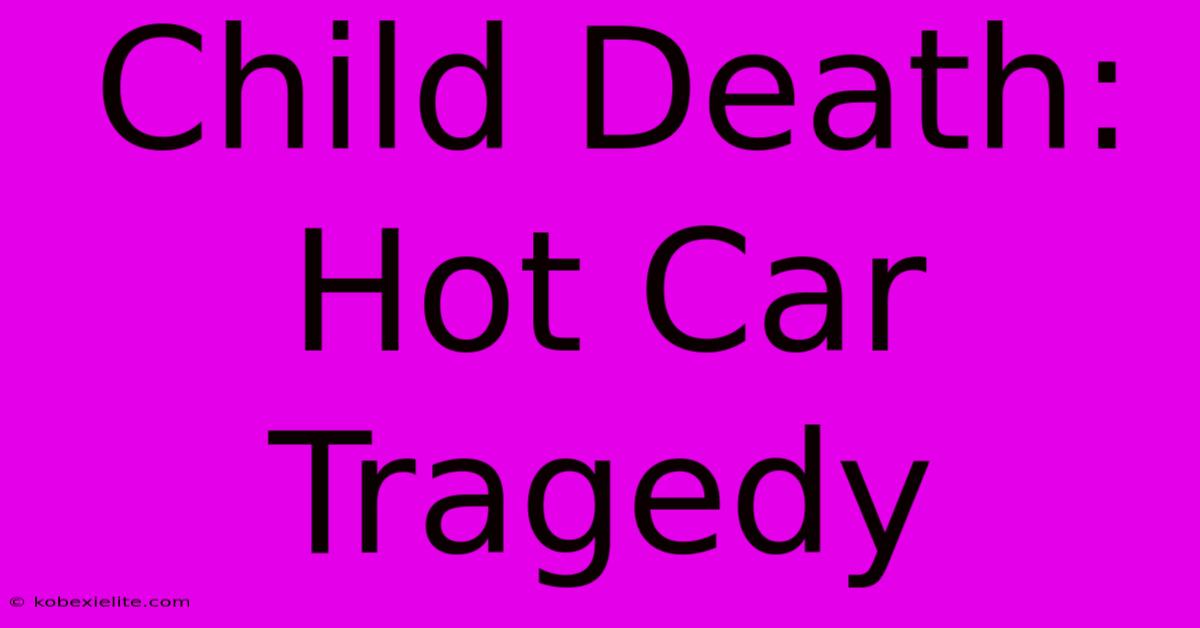Child Death: Hot Car Tragedy

Discover more detailed and exciting information on our website. Click the link below to start your adventure: Visit Best Website mr.cleine.com. Don't miss out!
Table of Contents
Child Death: Hot Car Tragedy – A Preventable Horror
Every year, heartbreaking headlines scream the same tragic story: a child has died after being left in a hot car. This isn't an accident of fate; it's a preventable tragedy fueled by forgetfulness, distraction, and a lack of awareness about the dangers of extreme heat. Understanding the risks and implementing preventative measures is crucial to saving lives.
The Dangers of Extreme Heat in Cars
The temperature inside a parked car can rise alarmingly quickly, even on mildly warm days. Within minutes, the interior can become a deadly oven. A car's temperature can increase by 20 degrees Fahrenheit in just 10 minutes, even with the windows slightly cracked. On a 70°F day, the temperature inside a car can soar to over 100°F in less than an hour. This extreme heat can lead to heatstroke, a life-threatening condition that can cause organ damage, brain damage, and death.
Factors Contributing to Hot Car Deaths:
- Forgotten Children: The most common cause is a parent or caregiver unintentionally leaving a child in the car. This can happen due to a change in routine, stress, or simply being overwhelmed.
- Children Unintentionally Entering Cars: Young children may climb into unattended vehicles, attracted by the novelty of the space or items left inside. This is particularly dangerous if they are unable to unlock the doors from the inside.
- Caregiver Distraction: A lapse in attention, even a brief one, can have devastating consequences. This is exacerbated by technology and multitasking.
Recognizing the Symptoms of Heatstroke in Children
Recognizing the signs of heatstroke is vital in a time-sensitive situation. Symptoms include:
- High body temperature: This is often the most obvious sign.
- Altered mental state: Confusion, lethargy, or unconsciousness.
- Rapid heartbeat: A fast or irregular pulse.
- Red, hot, and dry skin: Though sometimes skin can be clammy.
- Headache and dizziness: These can be early warning signs.
- Nausea and vomiting: These are common symptoms of heat exhaustion, which can progress to heatstroke.
If you suspect a child is suffering from heatstroke, immediately call emergency services and take these steps:
- Move the child to a cool place: Get them out of the hot car immediately.
- Remove excess clothing: Help to lower their body temperature.
- Cool the child down: Use cool water or ice packs to lower their body temperature gradually. Avoid using ice water directly on their skin.
- Monitor their breathing and pulse: Be vigilant until emergency services arrive.
Preventing Hot Car Deaths: A Proactive Approach
Preventing these tragedies requires a multi-faceted approach:
- Establish a Routine: Always check the back seat before locking your car. Place your bag, phone, or wallet in the back seat as a reminder.
- Use Technology: Consider using smartphone apps designed to alert caregivers if a child is left in the car.
- Communicate with Others: Inform caregivers and others who might be responsible for transporting children to be extra vigilant.
- Educate Yourself and Others: Spread awareness about the dangers of leaving children in hot cars.
- Consider Child Safety Alarms: Explore the availability of child safety alarms for vehicles.
This is not just about preventing a tragedy; it's about saving lives. Every single child's life is precious. Let's work together to ensure that these heartbreaking events become a thing of the past. The responsibility rests with all of us.
Further Resources:
(Note: I cannot provide direct links to external websites, but you can easily find reputable sources online by searching for organizations dedicated to child safety and heatstroke prevention.) Look for resources from organizations like the National Highway Traffic Safety Administration (NHTSA) and similar child safety organizations in your country.
This article aims to raise awareness and prevent child deaths in hot cars. Remember, vigilance, routine, and community awareness are key.

Thank you for visiting our website wich cover about Child Death: Hot Car Tragedy. We hope the information provided has been useful to you. Feel free to contact us if you have any questions or need further assistance. See you next time and dont miss to bookmark.
Featured Posts
-
Armias Goal Wins Canadiens Game
Feb 06, 2025
-
Armstrong Loan Decision Due
Feb 06, 2025
-
Sixers Waste Resources Kj Martin Trade
Feb 06, 2025
-
Middle East Europe Reject Trump Plan
Feb 06, 2025
-
Mc Davids Shot Selection Skinner Fan
Feb 06, 2025
